张欣 cge讲义
- 格式:ppt
- 大小:647.00 KB
- 文档页数:30
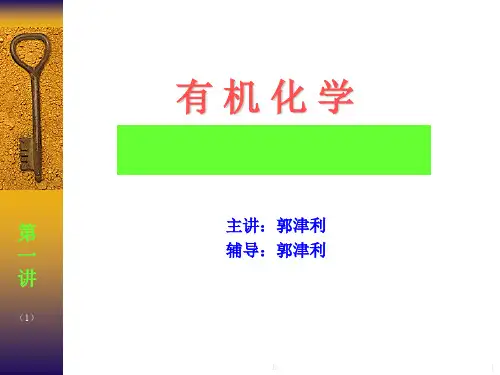
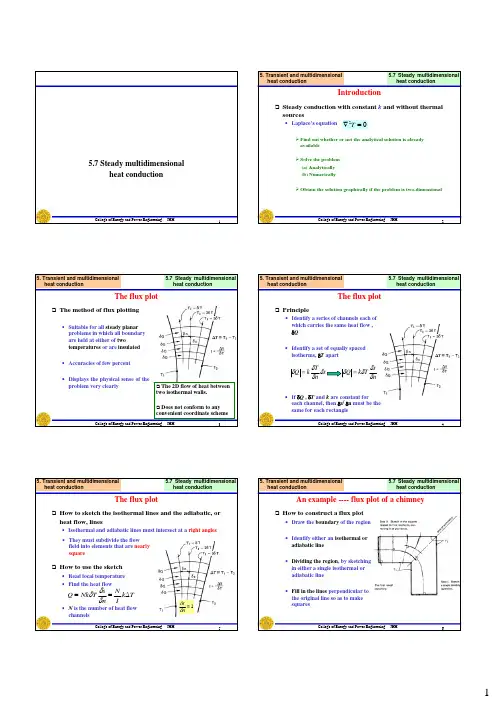
College of Energy and Power Engineering JHH15.7 Steady multidimensionalheat conductionCollege of Energy and Power Engineering JHH2IntroductionSteady conduction with constant k and without thermal sourcesLaplace’s equation¾Find out whether or not the analytical solution is already available¾Solve the problem (a) Analytically (b) Numerically¾Obtain the solution graphically if the problem is two-dimensional5.7 Steady multidimensional heat conduction5. Transient and multidimensional heat conduction 02=∇T College of Energy and Power Engineering JHH3The flux plotThe method of flux plottingSuitable for all steady planar problems in which all boundary are held at either of twotemperatures or are insulated Accuracies of few percentDisplays the physical sense of the problem very clearly5. Transient and multidimensional heat conduction The 2D flow of heat between two isothermal walls. Does not conform to any convenient coordinate scheme5.7 Steady multidimensionalheat conduction College of Energy and Power Engineering JHH4The flux plotPrincipleIdentify a series of channels each of which carries the same heat flow , δQ s nT kQ δδδδ=ns Tk Q δδδδ=5. Transient and multidimensional heat conduction 5.7 Steady multidimensional heat conductionIdentify a set of equally spaced isotherms, δT apartIf δQ , δT and k are constant foreach channel, then δs/δn must be the same for each rectangleCollege of Energy and Power Engineering JHH5The flux plotHow to sketch the isothermal lines and the adiabatic, or heat flow, linesIsothermal and adiabatic lines must intersect at a right angles 1≅ns δδHow to use the sketchRead local temperature Find the heat flowN is the number of heat flow channelsT k IN n s TNk Q Δ==δδδ5. Transient and multidimensional heat conduction 5.7 Steady multidimensionalheat conduction They must subdivide the flow field into elements that are nearly squareCollege of Energy and Power Engineering JHH6An example ----flux plot of a chimneyHow to construct a flux plotDraw the boundary of the region Identify either an isothermal or adiabatic line Dividing the region , by sketching in either a single isothermal or adiabatic line Fill in the lines perpendicular to the original line so as to make squares5. Transient and multidimensional heat conduction 5.7 Steady multidimensional heat conductionCollege of Energy and Power Engineering JHH7An example ----flux plot of a chimneySuccessive subdividing of the squares, make the final grid, but do not make the grid very fine Check whether any large, ill-shaped region are correct by fill them with an extraisothermal and adiabatic line The flow channels need not come out even. To calculate the heat flow5. Transient and multidimensional heat conduction Tk T k IN Q Δ=Δ=4)14.6(25.7 Steady multidimensionalheat conduction College of Energy and Power Engineering JHH8The flux plotA flux plot with no axis of symmetry to guide construction.5. Transient and multidimensional heat conduction 5.7 Steady multidimensional heat conductionCollege of Energy and Power Engineering JHH9Example 5.8Metal-insulation-metal composite wall, one metal wall with rib.To find Q , T A =?5. Transient and multidimensionalheat conduction Heat transfer through a wall with isothermal ribs.W/m54.10 )040)(12.0(6.5)15.6(2 =−=Δ=Tk IN Q solution 6.51.20400=−−A T C T o A 15)00.4(6.51.2=−=5.7 Steady multidimensionalheat conduction 0.12/k W m K=⋅College of Energy and Power Engineering JHH10The shape factorDefinitionFor steady problems with two isothermal surfaces , heat conduction shape factor S is defined asIn 2D problem S is dimensionless (Q in the units of W/m )In 3D problem S has units of m (Q in the units of W )5. Transient and multidimensional heat conduction T Sk Q Δ≡T k I N Q Δ=1 kSR R T Q t t =Δ=tkR S 1=Tk Q S Δ≡/I N S = 5.7 Steady multidimensional heat conductionCollege of Energy and Power Engineering JHH11The shape factorShape factor summarize a heat conduction solution in a given configurationOnce S is known, it can be used again and againS is nondimensional in 2D configurations means that Q is independent of the size of the body.The shape factor for two similar bodies of different size .)/ln(210i t cyl r r kR S π==)/ln(2104/i t cyl r r kR S π==5. Transient and multidimensional heat conduction When breadth is increased so as to increase Q , its thickness is also increased so as to decrease Q by the same factor5.7 Steady multidimensionalheat conduction College of Energy and Power Engineering JHH12Example 5.10To find S for a thick hollow sphere.5. Transient and multidimensional heat conduction 21C rC T +=oo i i T r r T T r r T ====)( and )(⎥⎦⎤⎢⎣⎡−−−Δ+=i o o i o o i i r r r r r r r r T T T )(T k r r r r dr dT kAQ i o oi Δ−=−=π4m 4io oi r r r r S −=π0)(122=∂∂∂∂rTr r r 5.7 Steady multidimensional heat conductionEq. b.c.’sCollege of Energy and Power Engineering JHH13The shape factorConduction shape factor5. Transient and multidimensional heat conduction Q TS k =ΔTemperature far from sphere is T ∞5.7 Steady multidimensionalheat conduction College of Energy and Power Engineering JHH14The shape factor5. Transient and multidimensional heat conduction 5.7 Steady multidimensional heat conductionCollege of Energy and Power Engineering JHH15The shape factor 5. Transient and multidimensional heat conduction 5.7 Steady multidimensionalheat conduction College of Energy and Power Engineering JHH16The shape factor5. Transient and multidimensional heat conduction 5.7 Steady multidimensional heat conductionCollege of Energy and Power Engineering JHH17The problem of locally vanishing resistanceTwo different temperatures are specified on adjacent sides of a square5. Transient and multidimensional heat conduction Resistance vanishes where two isothermal boundaries intersect.The shape factorThe problem violate the rule thatisothermals can not intersect∞=∞==4IN S 5.7 Steady multidimensionalheat conductionCollege of Energy and Power Engineering JHH185.8 Transient multidimensional heatconduction⎯The tactic of superpositionCollege of Energy and Power Engineering JHH19The tactic of superpositionVarious solid bodies whose transient cooling can be treated as the product of one-dimensional solutions 5. Transient and multidimensional heat conduction 5.8 Transient multidimensional heatconduction-The tactic of superpositionThe temperature response of a longsquare rod interpreted as the product of two infinite slab solutions.inf slab inf slab (,,) [(,Fo , Bi )][(,Fo , Bi )]i x x x x y y y y T x y t T T T ξξ∞∞−Θ≡−=Θ×Θ2b2axyCollege of Energy and Power Engineering JHH20The tactic of superpositionLong rectangular rodEq.i.c b.c.’s2b2axy22221x y tα∂Θ∂Θ∂Θ+=∂∂∂0(,,)(,,)0, (,,)(,,)0, x ax x ay by y bx y x y h x x k x y x y h yy k ττττ======∂Θ∂Θ==−Θ∂∂∂Θ∂Θ==−Θ∂∂(,,)((,,))/()i x y t T x y T T T τ∞∞Θ=−−(,,0)(,,)1i T x y T x y t T T ∞∞−Θ==−5. Transient and multidimensional heat conduction 5.8 Transient multidimensional heat conduction-The tactic of superpositionCollege of Energy and Power Engineering JHH21The tactic of superpositionlet Where*(,,)(,)(,)x y x y t x t y t Θ=Θ⋅Θ(,)(,)(,), (,)x y i i T x T T y T x t y t T T T T ττ∞∞∞∞−−Θ=Θ=−−(,)x x t Θ2201(,0)10x xx xx x x x ax axt x x hx k α===⎧∂Θ∂Θ=⎪∂∂⎪Θ=⎪⎪∂Θ⎨=⎪∂⎪⎪∂Θ=−Θ⎪∂⎩2201(,0)10y yy yy yyy by b yt y y hy k α===⎧∂Θ∂Θ=⎪∂∂⎪⎪Θ=⎪⎪∂Θ⎨=⎪∂⎪⎪∂Θ⎪=−Θ∂⎪⎩(,)y y t Θ5. Transient and multidimensionalheat conduction 5.8 Transient multidimensional heatconduction-The tactic of superposition and is the solution for the problem College of Energy and Power Engineering JHH22The tactic of superpositionTo prove is the solution of the original equation, substitute into the LHS of the original equation*(,,)x y t Θ*(,,)x y t Θ222*2*2222y x y x x y x y ∂Θ∂Θ∂Θ∂Θ+=Θ+Θ∂∂∂∂*2*2*2211y x y x t t t x y αα∂Θ⎛⎞∂Θ∂Θ∂Θ∂Θ=Θ+Θ=+⎜⎟∂∂∂∂∂⎝⎠*(,,)x y t Θ5. Transient and multidimensional heat conduction 5.8 Transient multidimensional heat conduction-The tactic of superposition1x y t α∂Θ=Θ∂1yxtα∂Θ+Θ∂To substitute into RHS of original equationInitial condition and boundary condition can be proved in the same wayCollege of Energy and Power Engineering JHH23The tactic of superpositionThe temperature response of a stubby cylinder can be analyzed as the product of infinite slab and infinite cylinder solutions.T responseWhere]),([]),([),,(∞∞∞−×−=−T t r T T t z T T t z r T cyl slab )]Bi ,Fo ,([)]Bi ,Fo ,([),,(c c cyl inf s s slab inf ρξΘ×Θ=−−≡Θ∞∞T T T t z r T i 0c c 200s s 2, Fo and Bi 1, Fo and Bi hr rt r r k z t hLL L kαραξ====+==5. Transient and multidimensional heat conduction 5.8 Transient multidimensional heatconduction-The tactic of superposition College of Energy and Power Engineering JHH24The tactic of superpositionThe temperature responseof a point within a corner analyzed as the product of three semi-infinite region solutions.5. Transient and multidimensional heat conduction )],([)],([)],([),,,(3semi 2semi 1semi 321βζβζβζΘ×Θ×Θ=−−≡Θ∞∞T T T t x x x T i 5.8 Transient multidimensional heat conduction-The tactic of superposition311123 x x x tttζζζααα===h tkαβ≡College of Energy and Power Engineering JHH25Example 5.12A very long 4 cm square iron rod at T i =100o C, T ∞=20o C, h=800W/m 2KTo find: T along the line of x 1=0cm and x 2=1cm, at t =10s5. Transient and multidimensional heat conduction inf slab 11s 1s 1 inf slab inf slab 22s 2s 2 inf slab (,Fo ,Bi )(0,0.565, 0.2105)0.93(,Fo , Bi )](0.5,0.565, 0.2105)0.91ξξΘ=Θ=Θ=Θ=846.091.093.0rod inf =×=Θ200.846 or 87.710020o i T T T T CT T ∞∞−−===−−42=L 2x 1x 5.8 Transient multidimensional heatconduction-The tactic of superposition1x 2x 2Fo=/0.565 Bi=/0.2105t L hL k α==College of Energy and Power Engineering JHH26Summary of heat conduction1 Introduction1.2Relation of heat transfer to thermodynamics¾The First Law with work equal to zero1.3 Modes of heat transfer¾Heat conduction–Fourier’s law–Thermal conductivity values–One-dimensional heat diffusion equation¾Heat convection–The physical process–Lumped-capacity solution¾Radiation–The electromagnetic spectrum –Black bodies–The Stefan-Boltzmann lawCollege of Energy and Power Engineering JHH27Summary of heat conduction2. Heat conduction concepts, thermal resistance, and the overall heat transfer coefficient2.1The heat diffusion equation¾3D, internal heat source, transient2.2 Solutions of the heat diffusion equation ¾1D, integration2.3 Thermal resistance and the electrical analogy¾Contact resistance¾Resistances for slab, cylinders and sphere2.4 Overall heat transfer coefficient, U¾Definition,Typical values of U2222221T T T qT x y z k tα∂∂∂∂+++=∂∂∂∂ College of Energy and Power Engineering JHH28Summary of heat conduction3. Heat exchanger design3.1 Function and configuration of heat exchangers3.2 Evaluation of the mean temperature difference in a heat exchanger¾Logarithmic mean temperature difference (LMTD) ¾Extended use of the LMTD ¾Limitations¾LMTD correction factor, F3.3 Heat exchanger effectiveness¾Effectiveness-NTU method3.4 Heat exchanger designCollege of Energy and Power Engineering JHH29Summary of heat conduction4. Analysis of heat conduction and steady 1D problems4.1 The well-posed problem 4.2 The general solution¾Separation of variables4.3 Dimensional analysis¾The Buckingham pi-theorem and its application4.4 T distribution in a slab with or without 4.5 Fin design¾Analysis of a one-dimensional fin–The equations–Temperature distribution in a one-dimensional fin with the tip insulated–Physical significance of mL¾Fin design (efficiency and effectiveness)q College of Energy and Power Engineering JHH30Summary of heat conduction5. Transient and multidimensional heat conduction5.2 Lumped-capacity solutions¾Dimensional analysis of transient heat conduction, Bi<0.1¾Electrical analogies to the lumped-thermal-capacity problem5.3 Transient conduction in a one-dimensional slab 5.4 Temperature-response charts5.6 Transient heat conduction to a semi-infinite region¾Solution aided by dimensional analysis5.7 Steady multidimensional heat conduction¾The flux plot ¾The shape factor5.8 Transient multidimensional heat conduction-The tactic of superposition5. Transient and multidimensionalheat conductionHomework5.185.35College of Energy and Power Engineering JHH31。
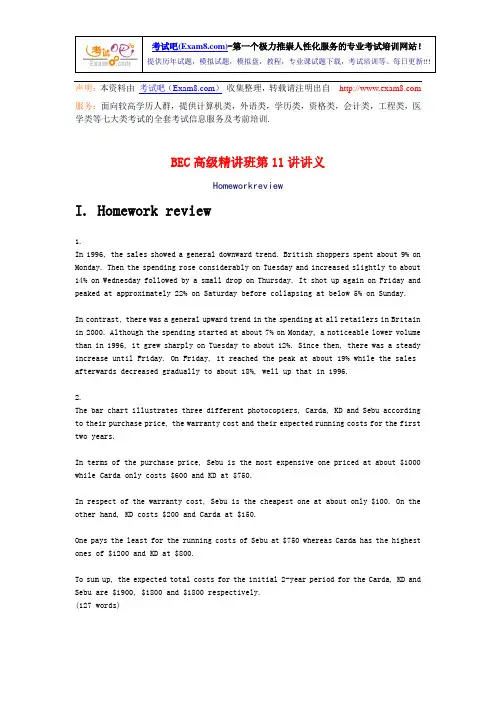
声明:本资料由考试吧()收集整理,转载请注明出自服务:面向较高学历人群,提供计算机类,外语类,学历类,资格类,会计类,工程类,医学类等七大类考试的全套考试信息服务及考前培训.BEC高级精讲班第11讲讲义HomeworkreviewI. Homework review1.In 1996, the sales showed a general downward trend. British shoppers spent about 9% on Monday. Then the spending rose considerably on Tuesday and increased slightly to about 14% on Wednesday followed by a small drop on Thursday. It shot up again on Friday and peaked at approximately 22% on Saturday before collapsing at below 5% on Sunday.In contrast, there was a general upward trend in the spending at all retailers in Britain in 2000. Although the spending started at about 7% on Monday, a noticeable lower volume than in 1996, it grew sharply on Tuesday to about 12%. Since then, there was a steady increase until Friday. On Friday, it reached the peak at about 19% while the sales afterwards decreased gradually to about 18%, well up that in 1996.2.The bar chart illustrates three different photocopiers, Carda, KD and Sebu according to their purchase price, the warranty cost and their expected running costs for the first two years.In terms of the purchase price, Sebu is the most expensive one priced at about $1000 while Carda only costs $600 and KD at $750.In respect of the warranty cost, Sebu is the cheapest one at about only $100. On the other hand, KD costs $200 and Carda at $150.One pays the least for the running costs of Sebu at $750 whereas Carda has the highest ones of $1200 and KD at $800.To sum up, the expected total costs for the initial 2-year period for the Carda, KD and Sebu are $1900, $1800 and $1800 respectively.(127 words)VocabularyStudyII. Vocabulary Studyu Animal words in the business contextwatchdog noun [countable]1 a person or group of people whose job is to protect the rights of people who buy things and to make sure companies do not do anything illegal or harmful 监管人,监管机构a consumer watchdog 一个消费者的监管机构top dog noun [countable]the person who has the most power in a group, especially after a struggle 掌管大权的人He always wanted to be the one in control, the top dog. 他总是想成为可以控制一切的人,即长官大权的人。

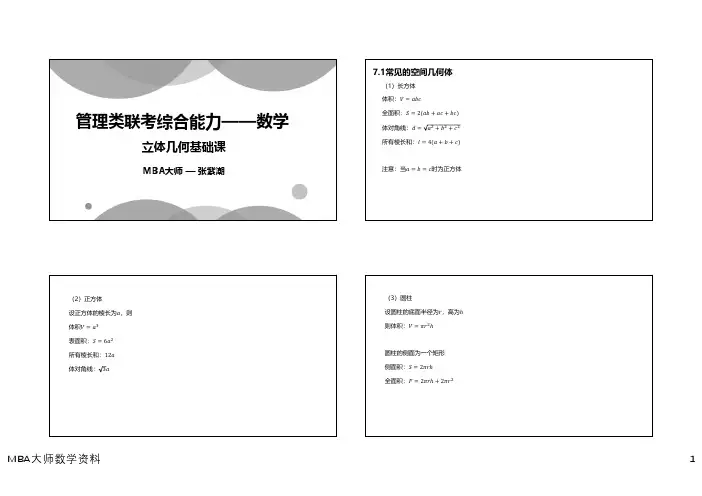
管理类联考综合能力——数学
MBA大师—张紫潮
立体几何基础课
7.1常见的空间几何体
(1)长方体体积:V abc
全面积:S 2 ab ac bc 体对角线:d a b c 所有棱长和:l 4 a b c
注意:当a b c 时为正方体
(2)正方体
设正方体的棱长为a ,则体积V a 表面积:S 6a 所有棱长和:12a 体对角线:3a
(3)圆柱
设圆柱的底面半径为r ,高为ℎ则体积:V πr ℎ
圆柱的侧面为一个矩形侧面积:S 2πrℎ全面积:F 2πrℎ 2πr
(4)球体:
半径为r的球体,体积V
πr 表面积S 4πr
7.2内切球,外接球半径
设正方体的棱长为a,球体的半径为r
则正方体的内切球半径r
正方体的外接球半径:r
a
正方体的外接半球半径:r
a
7
7.3 立方体的切割,融合问题
A. 对于几何体的切开问题,新增加的表面积等于切面面积的2倍,对于融合问题,减少的表面积等于融合面积的2倍。
对于融合问题,我们主要借助的是体积不变进行求。
注意:无论是切开还是融合,表面积都发生了变化,但是体积不变
B. 若将一个大的金属球融化成n 个小金属球,那么表面积为原来的n倍若将一个大正方体表面全图涂上漆,据成n 个小正方体,则有:三面涂漆的为:8个
两面涂漆的为12(n 2)个
一面涂漆的为6 n 2 个
没有涂漆的为 n 2 个
THANK YOU FOR WATCHING。
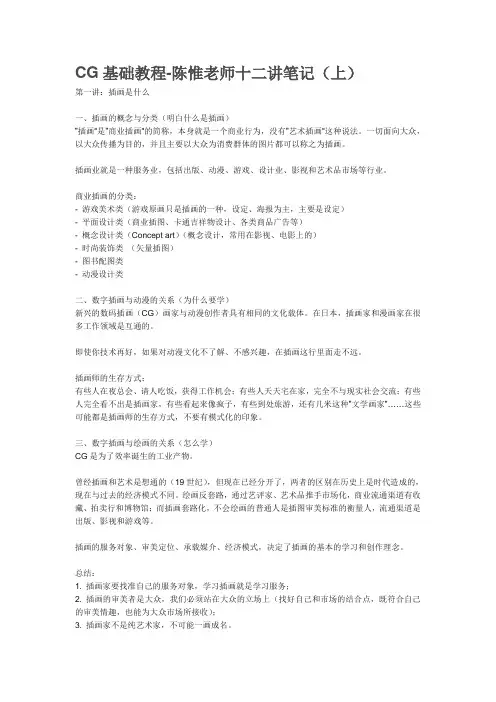
CG基础教程-陈惟老师十二讲笔记(上)第一讲:插画是什么一、插画的概念与分类(明白什么是插画)”插画“是”商业插画“的简称,本身就是一个商业行为,没有”艺术插画“这种说法。
一切面向大众,以大众传播为目的,并且主要以大众为消费群体的图片都可以称之为插画。
插画业就是一种服务业,包括出版、动漫、游戏、设计业、影视和艺术品市场等行业。
商业插画的分类:- 游戏美术类(游戏原画只是插画的一种,设定、海报为主,主要是设定)- 平面设计类(商业插图、卡通吉祥物设计、各类商品广告等)- 概念设计类(Concept art)(概念设计,常用在影视、电影上的)- 时尚装饰类(矢量插图)- 图书配图类- 动漫设计类二、数字插画与动漫的关系(为什么要学)新兴的数码插画(CG)画家与动漫创作者具有相同的文化载体。
在日本,插画家和漫画家在很多工作领域是互通的。
即使你技术再好,如果对动漫文化不了解、不感兴趣,在插画这行里面走不远。
插画师的生存方式:有些人在夜总会、请人吃饭,获得工作机会;有些人天天宅在家,完全不与现实社会交流;有些人完全看不出是插画家,有些看起来像疯子,有些到处旅游,还有几米这种”文学画家”……这些可能都是插画师的生存方式,不要有模式化的印象。
三、数字插画与绘画的关系(怎么学)CG是为了效率诞生的工业产物。
曾经插画和艺术是想通的(19世纪),但现在已经分开了,两者的区别在历史上是时代造成的,现在与过去的经济模式不同。
绘画反套路,通过艺评家、艺术品推手市场化,商业流通渠道有收藏、拍卖行和博物馆;而插画套路化,不会绘画的普通人是插图审美标准的衡量人,流通渠道是出版、影视和游戏等。
插画的服务对象、审美定位、承载媒介、经济模式,决定了插画的基本的学习和创作理念。
总结:1. 插画家要找准自己的服务对象,学习插画就是学习服务;2. 插画的审美者是大众,我们必须站在大众的立场上(找好自己和市场的结合点,既符合自己的审美情趣,也能为大众市场所接收);3. 插画家不是纯艺术家,不可能一画成名。

图像记忆培训班课程(第二课)图像记忆培训班课程第二课:图像联结图像记忆第二步:图像联结图像联结:运用想象力把两个以上的图像生动地联系起来。
图像联结主要分为:两图联想、对应联想、串联联想1). 两图联想(两图联想定义:把两个简单的图像通过想象联结在一起。
例如:“自行车”和“奖杯”这两个词语,我们可以想象骑自行车比赛,最后获得了奖杯;也可以想象自行车后座放着一个奖杯;等等。
两图联想是最简单、最基础的图像联结。
)两图联想练习:老鼠——飞机:西瓜——老虎:苹果——雪梨:2).对应联想:(对应联想定义:把两组图像通过想象联结在一起。
“对应联想”和“两图联想”的差别是,对应联想里的两组图像可能会复杂一些,不一定是最简单的两个图像。
对应联想包括两图联想。
对应联想法就是在只有唯一对应关系的两个记忆对象之间进行联系,使双方形成紧密的对应关系,以提到一方就能马上想起另一方的记忆目的。
对于一些对应关系明确的记忆内容,我们就在问题和答案之间直接进行联系,这样在以后见到问题时回想一下联系就可以想起答案了。
)例子一,记忆世界地理之最:最长的河流——泥罗河联想:因为最长的河要流过很多地方,所以肯定会带走很多的泥和螺(尼罗河)。
最大的群岛---马来群岛联想:最小的洋---北冰洋联想:例子二,历史填空题:我国境内已知的最早人类是(元谋人)联想:最早的人类是长得像猿模(元谋)样的人。
井田制盛行于(西周)联想:最早掌握原始浇灌技术是在(夏朝)联想:例子三,两汉散文:司马迁——《史记》:死马还会拉屎刘向——《战国策》:贾谊——汉代文赋:班固——《汉书》:例子四,魏晋南北朝文学:范晔(ye)——《后汉书》:后汉书很多内容,需要不断的翻页。
刘勰xie——《文心雕龙》:干宝——《搜神记》刘义庆——《世说新语》3). 串联联想练习(直接用动作来联结):鹦鹉——钥匙——大门;钥匙——鹦鹉——大门;警察——沙发——石榴;警察——石榴——沙发;什么是串联联想法:串联联想法就如同竹签一样,它把要记忆的若干项内容串起来,形成一个整体,从而可以提一个而想出一大串。
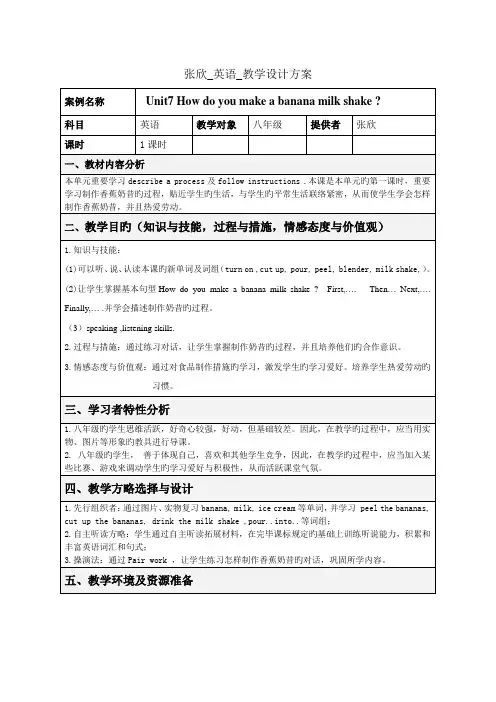
![讲师张欣欣_会话:「交流会」 [教案] [教学资源]](https://uimg.taocdn.com/6afa6ffb10a6f524ccbf85f6.webp)
教学设计课程名称: 授受表达赠送礼物年级: 九年级教材版本: 人民教育出版社《日语》九年级全一册主讲教师:张欣欣工作单位:成都外国语学校课时:第一课第3课时一,教材分析及对教材的使用调整授受表达为九年级全一册中第一课的“语法与表达学习”中的一个难点,也是历来学生较难掌握,容易混淆的点。
该语法在教材中的“会话”和“课文”中都有句子出现。
在教材配套的教师教学用书中,第1课时就安排了对会话的学习,第2课时复习会话,第3课时学习“あげる”,第4课时学习“もらう”。
我对教学安排作出了调整,首先,在第1课时学习会话时对会话中授受表达的语法不进行详细讲解,通过上下文和整个会话的情境,让学生能意会即可。
语法留待第3课时进行。
将教师用书第3课时和第4课时的安排进行融合,组成新的第三课时,并调整教科书中的相关练习。
二,学情分析授课班级学生为我校初三年级双语班学生,双语班学生同时学习英语和日语两门外语,时间紧,任务重,课后没有太多时间可用于日语。
经过初中2年的学习,学生掌握了一些日语基础知识,但相比单纯学习日语的初中生还是有一定的差距。
在日语教学中,我校初中的教学为“听说先行,读写跟上”,所以本课时在设计上也以听和说为主。
以听和说促进学生理解,主要培养学生对新知识的听解和口头运用。
三,教案过程:1.导入内容:“あげる”和“もらう”时间:3分钟利用ppt和教师肢体语言让学生理解“あげる”和“もらう”的意思和用法。
例句:1)コナン君はドラエモンにケーキをあげました。
2)ドラエモンはコナン君にケーキをもらいました。
疑问表达:1)ドラエモンはニャンコ先生に何をあげましたか。
2)ニャンコ先生はドラエモンに何をもらいましたか。
2.分组练习内容:练习“あげる”和“もらう”陈述和疑问的用法。
时间:10分钟问答游戏:学生分为2人一组,一人拿A卡片,一人拿B卡片,两张卡片上分别有信息和空格,运用“あげる”和“もらう”进行互相问答,完成各自的卡片填空。
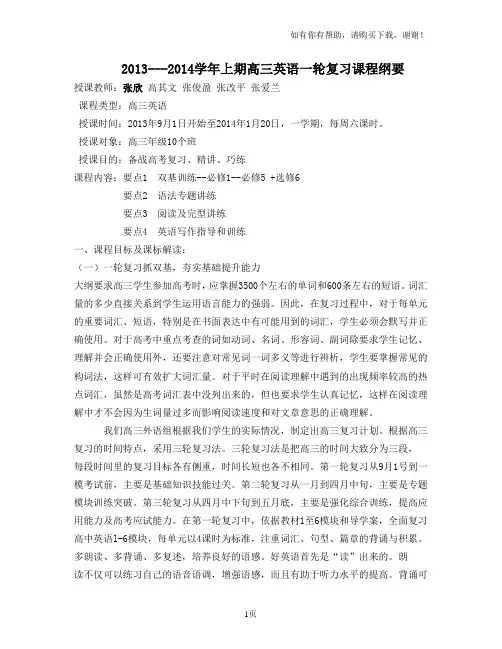
2013---2014学年上期高三英语一轮复习课程纲要授课教师:张欣高其文张俊盈张改平张爱兰课程类型:高三英语授课时间:2013年9月1日开始至2014年1月20日,一学期,每周六课时。
授课对象:高三年级10个班授课目的:备战高考复习、精讲、巧练课程内容:要点1 双基训练--必修1--必修5 +选修6要点2 语法专题讲练要点3 阅读及完型讲练要点4 英语写作指导和训练一、课程目标及课标解读:(一)一轮复习抓双基,夯实基础提升能力大纲要求高三学生参加高考时,应掌握3500个左右的单词和600条左右的短语。
词汇量的多少直接关系到学生运用语言能力的强弱。
因此,在复习过程中,对于每单元的重要词汇、短语,特别是在书面表达中有可能用到的词汇,学生必须会默写并正确使用。
对于高考中重点考查的词如动词、名词、形容词、副词除要求学生记忆、理解并会正确使用外,还要注意对常见词一词多义等进行辨析,学生要掌握常见的构词法,这样可有效扩大词汇量。
对于平时在阅读理解中遇到的出现频率较高的热点词汇,虽然是高考词汇表中没列出来的,但也要求学生认真记忆,这样在阅读理解中才不会因为生词量过多而影响阅读速度和对文章意思的正确理解。
我们高三外语组根据我们学生的实际情况,制定出高三复习计划。
根据高三复习的时间特点,采用三轮复习法。
三轮复习法是把高三的时间大致分为三段,每段时间里的复习目标各有侧重,时间长短也各不相同。
第一轮复习从9月1号到一模考试前,主要是基础知识技能过关。
第二轮复习从一月到四月中旬,主要是专题模块训练突破。
第三轮复习从四月中下旬到五月底,主要是强化综合训练,提高应用能力及高考应试能力。
在第一轮复习中,依据教材1至6模块和导学案,全面复习高中英语l-6模块,每单元以4课时为标准,注重词汇、句型、篇章的背诵与积累。
多朗读、多背诵、多复述,培养良好的语感。
好英语首先是“读”出来的。
朗读不仅可以练习自己的语音语调,增强语感,而且有助于听力水平的提高。